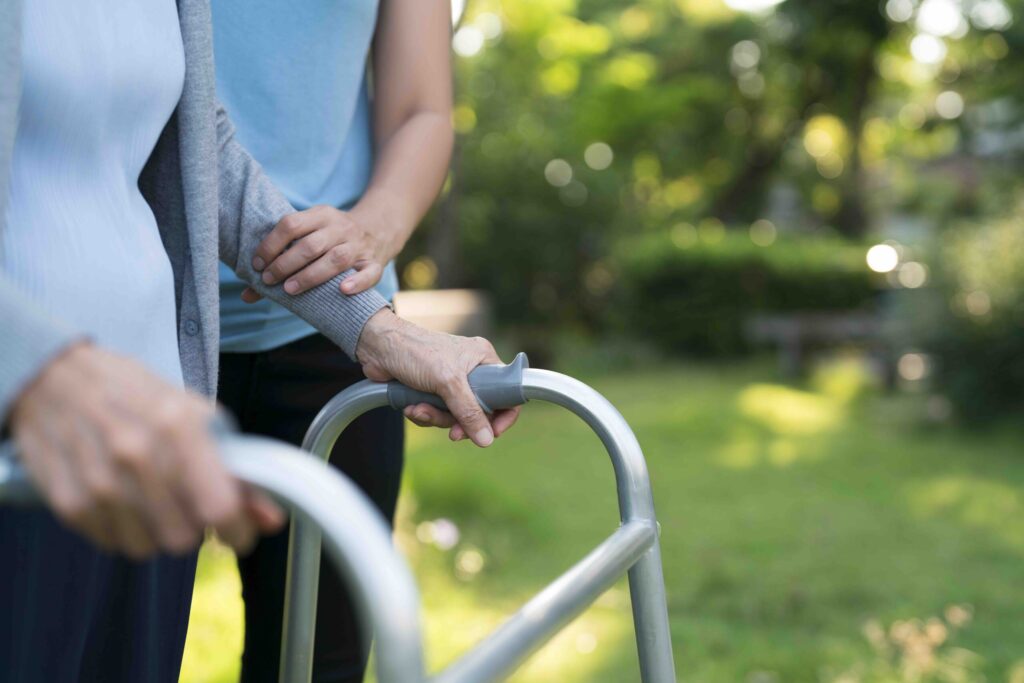
The U.S. Department of Health and Human Services is asking a judge to rule that it has the power to impose staffing requirements on nursing homes that collect billions of federal tax dollars through Medicaid and Medicare. (Photo via Getty Images)
The federal government is asking a judge to rule that it has the power to impose staffing requirements on nursing homes that collect billions of federal tax dollars through Medicaid and Medicare.
The request was made Friday in the form of a motion for summary judgment in a lawsuit filed by the nursing home industry. That lawsuit challenges the legality of newly imposed regulations that mandate minimum staffing levels in the Medicaid-certified care facilities that now provide care for 1.2 million elderly and disabled Americans.
In its motion, the U.S. Department of Health and Human Services says the staffing requirements are in response to “disturbing incidents of residents not being taken to the restroom or bathed for extended periods of time, frequent falls, lack of basic services like feeding or changing, and even abuse in cases where no one was watching.”
The agency says “hundreds of thousands of deaths in long-term care facilities during the COVID-19 pandemic laid bare the sweeping extent of the problem, with the ensuing evidence showing that facilities with higher staffing had fewer COVID-19 cases and deaths.”
The industry, represented in part by the lobbying organizations LeadingAge and the American Health Care Association, is arguing that DHHS’ Centers for Medicare and Medicaid Services, or CMS, exceeded its authority when it developed and then imposed staffing requirements that aren’t specifically spelled out in congressionally approved statute.
DHHS’ position is that the courts have repeatedly held that Congress gives agencies broad authority to enact specific, detailed regulations that are spelled out in legislation approved by Congress. Congress’ silence on the issue of staffing, the agency says, doesn’t mean CMS cannot impose staffing regulations.
“As the Supreme Court has recognized,” DHHS argues in its motion, “there is no ‘such thing as a canon of donut holes in which Congress’s failure to speak directly to a specific case that falls within a more general statutory rule creates a tacit exception.”
As an example, DHHS points to the court upholding a CMS regulation requiring health care workers to be vaccinated against COVID-19 for the protection of patients.
Both sides have sought summary judgment in the case, hoping to get a court ruling on the issue without the case going to trial. However the court rules on those motions, the issue may soon be rendered moot. The Trump administration is widely expected to eliminate the new mandates early next year as part of a broader regulatory rollback.
Fred Bentley, managing director for Medicare innovation at ATI Advisory, recently told McKnight’s Long-Term Care News “the staffing mandate is dead on arrival” once Trump takes office. He predicted the new administration will begin “scaling back or decreasing regulatory scrutiny” and inspections at nursing facilities.
Earlier this year, the Iowa Capital Dispatch reported that CMS data indicates 14% of Iowa’s 422 nursing facilities had been cited for insufficient staffing in fiscal year 2023, which was more than double the national average of 5.9%.
Only five other states – Hawaii, Michigan, Montana, New Mexico and Oregon — had a worse record of compliance with the sufficient-staffing requirement. Iowa’s neighboring states of Nebraska, South Dakota, Wisconsin and Missouri had no more than 2% to 6.8% of their facilities cited for insufficient staffing in 2023.
DHHS: Cost of new rules aren’t prohibitive
In its motion for summary judgment, DHHS argues that the minimum-staffing mandate will protect the health and safety of more than 1 million people whose age, ailments and injuries have left them unable to care for themselves.
The new rules specify that the facilities must have a registered nurse onsite 24 hours per day, seven days a week; offer 2.45 hours of care per day, per resident, by certified nursing assistants; and offer 3.48 hours of care per resident, per day, in total nurse staffing.
Those standards, DHHS argues, “mark the culmination of a decades-long process, beginning with Congress’s passage of the landmark Federal Nursing Home Reform Act in 1987.” DHHS adds that nursing homes that object to the new standards have the option of dropping out of the Medicare and Medicaid programs and accepting only private-pay residents.
With regard to industry complaints about the cost of adding additional staff, DHHS says it has established a $75 million grant program to expand the nursing workforce and help care facilities meet the new requirements. The agency has also agreed to a set of staggered implementation dates, allowed financial-hardship exemptions, and provided additional flexibility for homes in rural areas where the workforce shortage is acute.
The industry, DHHS argues, does “not dispute that establishing a minimum required floor for long-term care staffing protects the health and safety of those facilities’ residents.” Instead, the agency claims, industry officials are focusing their case “exclusively on the economic and political” impact of the new mandate.
“Many facilities already meet one or more of the minimum standards,” DHHS argues in its motion, pointing to a study that shows that as of May 2024, 78% of facilities currently provided at least 24 hours of total registered nurse staffing per day, and 59% of facilities were staffed at or above the 3.48 hours requirement for total nurse staffing.

